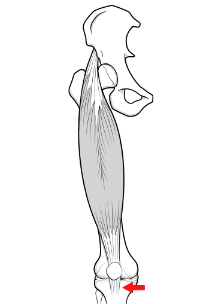A patellar tendon rupture is a partial or complete breaking of the patellar tendon under the kneecap.


Because the tendon is part of a chain that includes the quadriceps muscle, a rupture will result in retraction of the upper part of the quads.
Causes of patellar tendon rupture
Patellar tendon ruptures are often caused by direct or indirect trauma in the younger patient, but the tendon can also rupture as a consequence of patellar tendinopathy or overuse, such as in jumping sports or weightlifting. They may also occur after total knee replacement. The rupture may occur when the quads muscles are suddenly contracted when the knee is slightly bent.
The tendon may rupture through the mid-substance of the tendon, usually at the upper end, but the problem may also be one of an avulsion where the lower part pulls away from the bone of the tibia where it is normally inserted.
Diagnosis of patellar tendon rupture
The patient may experience sudden pain, and fall and be unable to take weight on getting up. The area around the patella may be swollen and if the rupture is complete rather than partial the kneecap may 'ride high' and a gap may be palpable below it. In a complete rupture or avulsion it is impossible to fully extend the knee.